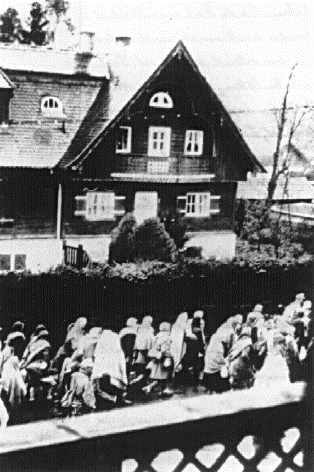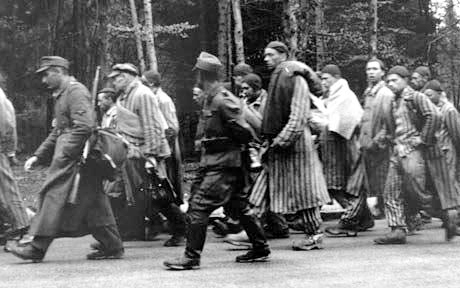Jewish Prisoners marched out of Dachau

Dachau prisoners marching
through a German village
Photo Credit: USHMM
Acting on Hitler's orders, the Commandant
of Dachau, Wilhelm Eduard Weiter, made an attempt to evacuate
the Dachau main camp before the American liberators arrived.
On April 26th, 1945, Weiter left the camp with a transport of
prisoners bound for Schloss Itter, a subcamp of Dachu in Austria.
On that same day, 1,759 Jewish prisoners were put on a train
that was headed south. One of the survivors of this train was
Mendel Rosenberg.
Also on April 26th, there were 6,887
other prisoners, half of whom were Jews, that started on a march
south to the mountains.

Russian POWs and Jews
on death march out of Dachau
One of the prisoners who survived this
march was Samuel Pisar, a Polish Jew who emigrated to America
after the war, became an international lawyer and wrote a book
entitled "Of Blood and Hope." Pisar was 13 years old
when the Bialystock ghetto in northeastern Poland was liquidated.
He was sent to the extermination camp at Majdanek, but his mother
and younger sister were sent to Auschwitz. His father had already
been shot by the Gestapo. A few months later, Pisar was transferred
to Auschwitz where he was given a job working near the crematoria
at Birkenau. He could hear the cries of the innocents as they
were herded into the gas chambers while an orchestra played classical
music. When Auschwitz was evacuated in January 1945, Pisar was
one of the prisoners on the death march out of the camp; he ended
up in Dachau where his misery continued. When American planes
strafed the column of Jews marching out of Dachau, he managed
to escape and was eventually rescued by American soldiers. He
had just turned 16 and had survived three long years of Nazi
persecution.
Another survivor of the march out of
Dachau was Jack Adler,
who was just 15 at the time. He emigrated to America in 1946;
his 12 year old sister had been gassed at Auschwitz and 78 members
of his extended family had perished in the Holocaust. Adler was
saved from the gas chamber because he was selected for medical
experiments, but he moved himself to another barrack where the
inmates were slave laborers. He survived the march out of Auschwitz
in January 1945 and was eventually brought to Dachau. When he
was liberated from the march out of Dachau by American soldiers,
he weighed only 66 pounds.
Morris Friebaum lost his whole family
in the Holocaust when they were sent to Treblinka from the Warsaw
ghetto. Morris escaped from the ghetto and lived on his own in
the Polish countryside, stealing and begging for food, and sleeping
in barns. When he was finally caught, he was sent to Auschwitz,
where he survived the selections for the gas chamber. Near the
end of the war, he was sent to a small camp in Hessental, Germany.
When this camp was evacuated, the prisoners were put on a train
which was bombed by Allied planes. Morris and 30 others who were
injured were taken to Dachau. In the final days of the war, Morris
was one of the Jewish prisoners who were marched out of Dachau
and finally set free by Allied troops on May 2, 1945.
Also among the prisoners on the march,
who were liberated by the Americans, was Majir Korenblit, who
changed his name to Major Kornblit when he moved to Ponca City,
Oklahoma in 1951. In 1983, his son Michael Korenblit co-authored
a book about the Holocaust experience of his father and his mother,
Mania, who changed her name to Manya after the war. The book
is entitled "Until We Meet Again: A True Story of Love and
War, Separation and Reunion."
After the Nazis conquered Poland in September
1939, Majir Korenblit and his teen-aged sweetheart Mania hid
from the Gestapo, along with a handful of other Jews, in a hand-dug
crater underneath a three-story haystack. Eventually, hunger
forced them out of their hiding place and they went to work for
the Nazis in the Hrubieszow ghetto. When the Gestapo came to
the ghetto, Major and Manya separated and escaped, spending the
next 2 1/2 years on the verge of death. Between them, Majir and
Mania survived 13 concentration camps, including Auschwitz where
both aquired a tattoo on their arms when they were registered.
Mania survived Auschwitz because she volunteered to work in Czechoslovakia
where she was liberated by the Soviet Army. Majir was sent to
Germany to work and wound up in Dachau in the last days of the
war.
Mania and Majir lost their entire families
in the Holocaust, except for Mania's younger brother Chaim, who
moved to Great Britain after the war. Mania and her brother were
reunited in 1982.
Philip
Riteman (Reitman) was also the
sole survivor in his family. He was 14 when he was sent to Auschwitz,
but he survived by lying about his age. After 2 and a half years
at Auschwitz-Birkenau, he was sent to Dachau and then to one
of the Kaufering sub-camps of Dachau near Landsberg am Lech.
In the last days before Dachau was liberated, Riteman was brought
back to the main camp. He was one of the prisoners who was sent
on the march out of Dachau, and rescued by American troops on
May 2, 1945.
Previous
Which
Division liberated Dachau?
Background
- the days just before the liberation
After the liberation
Back to Dachau
Liberation
Back to Table
of Contents
Home
This page was last updated on June 26,
2009
Jewish Prisoners marched out of Dachau Acting on Hitler's orders, the Commandant of Dachau, Wilhelm Eduard Weiter, made an attempt to evacuate the Dachau main camp before the American liberators arrived. On April 26th, 1945, Weiter left the camp with a transport of prisoners bound for Schloss Itter, a subcamp of Dachu in Austria. On that same day, 1,759 Jewish prisoners were put on a train that was headed south. One of the survivors of this train was Mendel Rosenberg. Also on April 26th, there were 6,887 other prisoners, half of whom were Jews, that started on a march south to the mountains.  One of the prisoners who survived this march was Samuel Pisar, a Polish Jew who emigrated to America after the war, became an international lawyer and wrote a book entitled "Of Blood and Hope." Pisar was 13 years old when the Bialystock ghetto in northeastern Poland was liquidated. He was sent to the extermination camp at Majdanek, but his mother and younger sister were sent to Auschwitz. His father had already been shot by the Gestapo. A few months later, Pisar was transferred to Auschwitz where he was given a job working near the crematoria at Birkenau. He could hear the cries of the innocents as they were herded into the gas chambers while an orchestra played classical music. When Auschwitz was evacuated in January 1945, Pisar was one of the prisoners on the death march out of the camp; he ended up in Dachau where his misery continued. When American planes strafed the column of Jews marching out of Dachau, he managed to escape and was eventually rescued by American soldiers. He had just turned 16 and had survived three long years of Nazi persecution. Another survivor of the march out of Dachau was Jack Adler, who was just 15 at the time. He emigrated to America in 1946; his 12 year old sister had been gassed at Auschwitz and 78 members of his extended family had perished in the Holocaust. Adler was saved from the gas chamber because he was selected for medical experiments, but he moved himself to another barrack where the inmates were slave laborers. He survived the march out of Auschwitz in January 1945 and was eventually brought to Dachau. When he was liberated from the march out of Dachau by American soldiers, he weighed only 66 pounds. Morris Friebaum lost his whole family in the Holocaust when they were sent to Treblinka from the Warsaw ghetto. Morris escaped from the ghetto and lived on his own in the Polish countryside, stealing and begging for food, and sleeping in barns. When he was finally caught, he was sent to Auschwitz, where he survived the selections for the gas chamber. Near the end of the war, he was sent to a small camp in Hessental, Germany. When this camp was evacuated, the prisoners were put on a train which was bombed by Allied planes. Morris and 30 others who were injured were taken to Dachau. In the final days of the war, Morris was one of the Jewish prisoners who were marched out of Dachau and finally set free by Allied troops on May 2, 1945. Also among the prisoners on the march, who were liberated by the Americans, was Majir Korenblit, who changed his name to Major Kornblit when he moved to Ponca City, Oklahoma in 1951. In 1983, his son Michael Korenblit co-authored a book about the Holocaust experience of his father and his mother, Mania, who changed her name to Manya after the war. The book is entitled "Until We Meet Again: A True Story of Love and War, Separation and Reunion." After the Nazis conquered Poland in September 1939, Majir Korenblit and his teen-aged sweetheart Mania hid from the Gestapo, along with a handful of other Jews, in a hand-dug crater underneath a three-story haystack. Eventually, hunger forced them out of their hiding place and they went to work for the Nazis in the Hrubieszow ghetto. When the Gestapo came to the ghetto, Major and Manya separated and escaped, spending the next 2 1/2 years on the verge of death. Between them, Majir and Mania survived 13 concentration camps, including Auschwitz where both aquired a tattoo on their arms when they were registered. Mania survived Auschwitz because she volunteered to work in Czechoslovakia where she was liberated by the Soviet Army. Majir was sent to Germany to work and wound up in Dachau in the last days of the war. Mania and Majir lost their entire families in the Holocaust, except for Mania's younger brother Chaim, who moved to Great Britain after the war. Mania and her brother were reunited in 1982. Philip Riteman (Reitman) was also the sole survivor in his family. He was 14 when he was sent to Auschwitz, but he survived by lying about his age. After 2 and a half years at Auschwitz-Birkenau, he was sent to Dachau and then to one of the Kaufering sub-camps of Dachau near Landsberg am Lech. In the last days before Dachau was liberated, Riteman was brought back to the main camp. He was one of the prisoners who was sent on the march out of Dachau, and rescued by American troops on May 2, 1945. PreviousWhich Division liberated Dachau?Background - the days just before the liberationAfter the liberationBack to Dachau LiberationBack to Table of ContentsHomeThis page was last updated on June 26, 2009 |